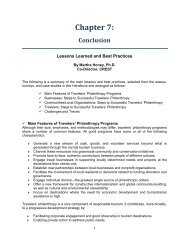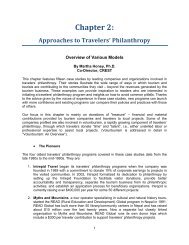Travelers' Philanthropy Handbook - Center for Responsible Travel
Travelers' Philanthropy Handbook - Center for Responsible Travel
Travelers' Philanthropy Handbook - Center for Responsible Travel
Create successful ePaper yourself
Turn your PDF publications into a flip-book with our unique Google optimized e-Paper software.
Two other interviewees commented that they witnessed the positive impact their site visits hadupon young people who were on their trip. A 51 year-old woman who visited Honduras withHolbrook <strong>Travel</strong> explained, “I brought my nine-year-old son on the trip and he was initiallyembarrassed to be bringing pencils <strong>for</strong> local school kids. However, the experience opened hiseyes and made him more aware of waste and consumption of our resources at home.” After atrip with Global Sojourns to South Africa, one donor recommended that “all high school studentsshould be required to experience a philanthropic trip like this in order to understand andappreciate our differences and our similarities.”• What Type of Project(s) have You Selected to Support and Why?Those surveyed used terms such as “educational”, “capacity building” and “sustainableempowerment” to describe the types of projects they have chosen to support. Many noted thatthey selected projects where they could see that the community was receiving direct economicor educational benefits. These included schools and educational programs such as GlobalSojourns’ empowerment workshops <strong>for</strong> girls. Holbrook <strong>Travel</strong>’s student trips to schools in CostaRica have helped raise funds <strong>for</strong> scholarships, built acomputer lab, and constructed a sidewalk along the busyroad leading to the school. A 63-year-old retired travelagent explained that she decided to donate to educationalprograms because “when people are literate they havemore control over their lives and it opens their world toopportunity.”Other projects supported by interviewees centered onmicro businesses. For instance, Global Sojourns supportsgarden projects in South Africa where communities growand sell produce. All READ library projects require abusiness model that sustains the library through revenuegenerated from community businesses. In Nepal theseinclude income from rental space and ambulance,telephone, and cable services. These projects “createownership and trickle down into the community,” explaineda 51 year-old male venture capitalist that traveled withMyths and Mountains.Those surveyed indicated that they favor small grass rootsinitiatives with low overhead, clear and measurable goals,Giving Circle trip in southern Africa.Credit:Global Sojournsand a sustainable model to ensure their longevity. Global Sojourns’ clients provide supportthrough “Giving Circles” that fund, typically <strong>for</strong> three years, small organizations and programs inAfrica that make a direct and lasting impact upon those they serve. For instance, several ofthose who traveled with Global Sojourns said that they chose to support Ray of Hope, anorganization that assists HIV/AIDS orphans with their education and other living expenses.Many of those interviewed emphasized that sustainability is an important component of projectsthey chose to support. A 69-year-old retired politician noted that he was pleased to find that“ongoing relationships are kept with all READ Global projects to assure their sustainability.”194















